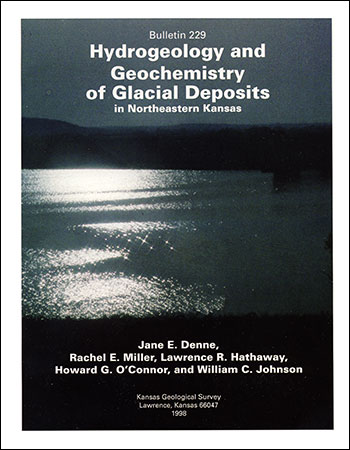Hydrogeology and Geochemistry of Glacial Deposits in Northeastern Kansas
by Jane E. Denne, Rachel E. Miller, Lawrence R. Hathaway, Howard G. O'Connor, and William C. Johnson

Originally published in 1998 as Kansas Geological Survey Bulletin 229. This is, in general, the original text as published. An Acrobat PDF version (63 MB) is also available. Plate 1 available separately.
Acknowledgments
We appreciate the assistance of many individuals and organizations during this study of northeastern Kansas. Many residents supplied information concerning the local geology, wells and test holes, water analyses, and historical information about ground-water development. The Kansas Department of Health and Environment and water superintendents provided information on public water supplies. The Division of Water Resources of the Kansas State Board of Agriculture provided information about surface-water and ground-water use and water rights. The U.S. Indian Health Service provided information about wells, test holes, and water use and quality on the Indian reservations. The Layne Western Company, Inc.; Bartlett and West Engineers, Inc.; Ground Water Associates, Inc.; Novak and Lay Engineers/ Surveyors; and several rural water districts provided data, specifications, logs, and other information used in this report. Many water-well drillers provided information about wells and test holes they had drilled.
We also appreciate support from the Kansas Geological Survey, especially Manoutch Heidari and Tom McClain. David Svingen, Mark Ziegler, Barbara Thomas, Michael Place, Ali Tabidian, Li Huei Chang, Wenzhi Liu, and Malia Rosner helped with field, laboratory, and computer work. Tom McClain, Allen Macfarlane, Marios Sophocleous, Tony Severini, and Dick Young, among others, provided field assistance; Munir Butt provided data management and pump-test programs; Kaye Long, Pamela Miller, Esther Price, and Anna Kraxner typed the manuscript. Analytical Services of the Kansas Geological Survey provided water analyses, and Exploration Services provided seismic profiles and drilled test holes and monitoring wells. Mark Schoneweis prepared preliminary figures, Jennifer Sims prepared the final figures, and Automated Cartography provided base maps and data plots. Robert Vincent, James Aber, Ron West, and Bob Ward provided critical review of the manuscript.
Abstract
Twelve counties (Atchison, Brown, Doniphan, Douglas, Jackson, Jefferson, Johnson, Leavenworth, Nemaha, Shawnee, Wabaunsee, and Wyandotte) in northeastern Kansas were glaciated during the Pleistocene Epoch. The glacial deposits consist of till, fluvial, loess, and lacustrine deposits locally totalling thicknesses of 400 ft (120 m). A major buried valley 3 mi (5 km) wide, 400 ft (120 m) deep, and 75 mi (120 km) long trends eastward across southern Nemaha, northern Jackson, and central Atchison counties. Several smaller tributary valleys can be identified in Atchison, Nemaha, Brown, Jackson, and Jefferson counties. Other buried valleys generally trend southward to the Kansas River valley or northward into Nebraska and Missouri. The glacial deposits filling the buried valleys locally are clayey. However, most valleys contain at least some water-bearing sand and gravel. Wells drilled into the best water-bearing sand and gravel deposits may yield as much as 900 gallons per minute (gpm; 0.06 m3/sm3/s), but less than 500 gpm (0.03 m3/s) is more common. The alluvial deposits of the Kansas and Missouri river valleys are the major sources of ground water in northeastern Kansas. Wells in these aquifers may have yields of 5,000 gpm (0.3 m3/s), but yields are more commonly less than 3,000 gpm (0.2 m3/s). We analyzed data from 80 pump tests using computer programs to find the best fit for transmissivity (1) and storage (S) values on glacial, alluvial, and bedrock aquifers. Transmissivities in the Missouri River valley alluvium ranged from 200,000 gallons per day per foot (gpd/ft) to 600,000 gpd/ft (2,000-7,000 m2/d), and storage values were between 0.001 and 0.0004. Tests in the Kansas River valley alluvium indicated transmissivities in the range 50,000-600,000 gpd/ft (600-7,000 m2/d) and storage values of 0.03. In the main buried valley across northeastern Kansas, the glacial deposits had T and S values of 2,500-25,600 gpd/ft (31.0-318 m2/d) and 0.00002-0.002, respectively. In the smaller buried valleys the glacial deposits had T values ranging from 1,500 gpd/ft to 100,000 gpd/ft (19-1,200 m2/d). Because of increasing population size in northeastern Kansas, appropriations of water for public and industrial water supplies have been increasing. Most of the pumpage comes from wells in the Kansas and Missouri river valleys. However, in 1981 the Division of Water Resources reported allocations of 1,466 acre-ft of water from wells tapping glacial aquifers associated with the main buried channel across Nemaha, Jackson, and Atchison counties and an additional 837 acre-ft from tributaries associated with the main buried channel. Nemaha County has the largest appropriation of water from the glacial aquifer (1,549 acre-ft/yr in 1983), and Wyandotte County has the largest appropriation of water from the alluvial aquifers (54,250 acre-ft/yr in 1983). Shawnee County has the largest number of ground-water appropriation rights (217). In 1981, for the 12-county study area, the Division of Water Resources found that 773 wells have ground-water appropriation rights. These 773 wells have appropriation rights for 140,484 acre-ft of water from alluvial aquifers, 5,290 acre-ft from glacial aquifers, and 2,146 acre-ft from Pennsylvanian and Permian rock aquifers. Maps for each county show the depth to bedrock, total thickness of Pleistocene sand and gravel deposits, estimated yield of wells, depth to water in wells and test holes, and the saturated thickness of Pleistocene deposits. A bedrock topographic map for the twelve counties was prepared from outcrop data and information from more than 5,000 water well, oil and gas, and test-hole logs. Ground waters from alluvial deposits are hard calcium bicarbonate waters that may have iron concentrations of several milligrams per liter. Sand and gravel associated with the glacial deposits generally yield hard calcium bicarbonate waters and may contain appreciable amounts of iron, manganese, sulfate, and chloride locally. Nitrate concentrations above 45 mg/L are noted in a number of wells of varying depth and aquifer source.
Kansas Geological Survey, Geohydrology
Placed on web March 1, 2015; originally published 1998.
Comments to webadmin@kgs.ku.edu
The URL for this page is http://www.kgs.ku.edu/Publications/Bulletins/229/index.html